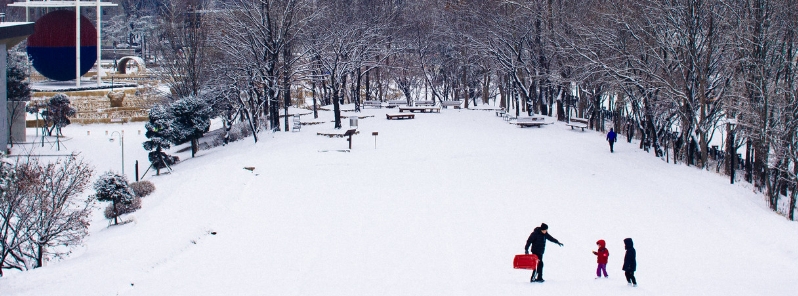Heaviest snowfall of the season hits Seoul, causing flight cancellations and traffic disruption, South Korea

Seoul received its largest daily snowfall this winter season on Monday, February 17, 2020, when up to 4.1 cm (1.6 inches) of snow fell in the South Korean capital, according to the Korea Meteorological Administration (KMA). The record came after the country felt its warmest January ever last month.
The temperatures also pummeled to -5.5 °C (22.1 °F) along with the heavy snowfall, but the chilly winds made it feel as if it was around -10.5 °C (13.1 °F), KMA added.
KMA also noted that some of the snow that fell in Seoul in the early morning began to melt, bringing down the volume of accumulated snow to 3.2 cm (1.3 inches) as of 0:00 UTC (09:00 LT).
Furthermore, along with Sunday's fall, snow on the ground measured 4.9 cm (1.9 inches) at around the same time.
The snow was still falling in all parts of the country, except the eastern coastal regions and several Geyongsang provincial areas, due to the influence of snow clouds generated by temperature differences between the lower atmosphere and the surface of the Yellow Sea.
29 cm (11.4 inches) of snow fell in Ulleung Island in the East Sea, while 5.7 cm (2.2 inches) fell in Gwangju, and 5.5 cm in Jeonju. Snow accompanied by winds led to flight disruptions in many parts of the country, and also created slippery conditions on the road.

The first snow of the season fell on November 15, 2019, but the amount was too small for accumulation. Small amounts of snow were recorded on December 7 last year and January 1 this year at a mere 0.3 cm and 0.4 cm (0.11 and 0.16 inches), respectively.
Monday's snowfall in Seoul as well as in other parts of the nation occurred after unseasonably warm weather this winter.
Last month was South Korea's warmest January on record as the average monthly temperature across the country was 2.8 °C (37 °F), which was 3.8 °C (6.8 °F) higher than the average January temperature recorded in the 1981 to 2010 period.


Featured image credit: Alex Barlow

Commenting rules and guidelines
We value the thoughts and opinions of our readers and welcome healthy discussions on our website. In order to maintain a respectful and positive community, we ask that all commenters follow these rules.